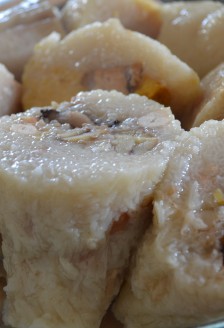Dragon Boat Dumplings
Dragon Boat Festival Dumplings
It’s Dragon Boat Festival! This is an annual festival falling on the 5th day of the 5th month in the Chinese Lunar year calendar. This year, it happens to be June 6, 2011 in Western calendars. There is a rich political and culinary history to the Dragon Boat Festival that roots back to ancient China in the state of Chu during the Zhou Dynasty (c. 340 BCE- 278 BCE). This was known as the Warring States Period, and during much political strife within the country, poet and royal descendant, Qu Yuan was accused of committing treason when he opposed the king’s decision to ally with the state of Qin. Shortly after, on the 5th day of the 5th month, Qu committed suicide by drowning himself in the Miluo River.
Dragon Boat Dessert Dumpling
Qu had many admirers and followers, and these people threw rice dumplings into the Miluo River to distract the fish from feasting on Qu’s corpse. Dragon boats were also launched on the river, and one man was assigned to each boat to beat a large drum to scare the fish from eating Qu’s corpse. And the age-old tradition of dragon boating and making and eating dumplings near the beginning of June began.
Dragon Boat dumpling with peanuts
I have celebrated this festival with my family for years. Dragon Boating is a very high profile sport across Canada and teams gain some pretty amazing corporate sponsorships from local companies. Dragon Boating is also popular internationally. Even Kate Middleton has tried it. Of course, I’m only in it for the food.
Unwrapping bamboo leaves from Dragon Boat Dumplings
Rice dumplings are called “zongzi” in Mandarin and “zong” in Cantonese. My grandma taught my mom and me how to make dumplings from scratch. We had to wake up early to purchase the long, thick bamboo leaves from Chinatown, and wash them thoroughly when we got home. Then we spent an entire morning boiling and cooling the leaves. The leaves cooled while we prepared the sticky rice and the savoury fillings for the dumplings, boiled Chinese mushrooms, peanuts, pork, salted duck egg yolks and shredded dried scallops. These ingredients were set up in an assembly line on the kitchen table. My grandma had a special way of folding the bamboo leaves into a very neat pouch to hold and mould the rice into a four cornered dumpling with room for filling in the centre. And no, I don’t know how to do it on my own, it was much too complicated for me to master as an 11-year-old. My dumplings turned out pretty deformed.
Dumplings filled with peanuts, pork and mushrooms
Dumplings filled with peanuts, pork and mushrooms
Wrapping dumplings is not only an art form but it’s also a time for families to gather around the kitchen table and spend quality time together.
We usually buy our dumplings now from Chinatown, T&T or even Crystall Mall. There are all different types of dumplings, even sweet dessert dumplings. These are my favourite. Both sweet and savoury dumplings are extremely easy to prepare as all the ingredients have been precooked. All you have to do is steam the dumpling until it’s soft. They actually make for great snacks and lunches. I’ve always thought that the carbohydrates from the sticky rice in the dumplings make them a great breakfast item before Dragon Boating.
Dragon Boat Dumplings with mung beans
Sticky rice is the main binding ingredient in these dumplings. Other staple ingredients are mung beans and peanuts. These ingredients are mainly boiled. I wasn’t a big fan of the fillings when I was little so my dad would usually just snip off the four corners of each dumpling for me. These corners only consisted of sticky rice.
Dragon Boat Dumplings with salted duck egg filling
These days, I’m still partial to the mung bean dumplings which usually come with one salted duck egg yolk in the centre. I’m not crazy about the egg yolk so I still dig it out of the dumpling and leave it aside. But the salty favours from the yolk brings out the subtle sweetness from the mung beans, and also adds a dramatic bright orange to the centre of the dumpling.
Dragon Boat Dumplings
The sweet sticky dessert dumplings are a traditional Taiwanese dish. The sticky rice in these dumplings is treated in liquid sodium carbonate making the rice stickier, sweeter, and a distinctive bright yellow colour. These dessert dumplings can either be filled or unfilled and can be eaten with syrup. I like the ones filled with red bean paste.
Dessert Dumpling with sticky rice and red bean paste filling
Dessert Dumpling with sticky rice and red bean paste filling
Happy Dragon Boat Festival! Make sure you eat lots of dumplings!




2 Responses to Dragon Boat Dumplings
Buddha Girl
on June 6, 2011
Reply
Actually, Taiwanese-style zonzi (粽子) is not the sweet type, it’s mainly the savoury ones. Within Taiwan, the northern part and the southern part have different ways of making and cooking the zongzi, they even use different types of leaves.
The sweet ones derived from northern China and were popularized in mainly HK and Taiwan (when the ROC government moved from mainland to the island). Fillings ranged from none to red bean paste, green bean paste, or some kind of sweet paste.
food punk
on June 6, 2011
Reply
Thanks for reading! It’s always great to learn more about this special festival!